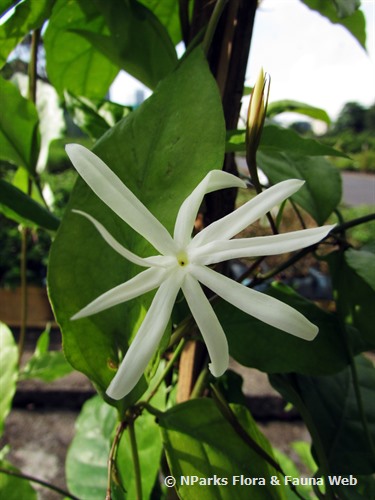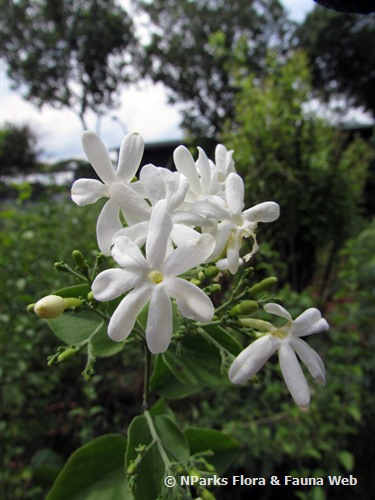.jpg)
Back
Jasminum sambac 'Grand Duke of Tuscany'
| Family Name: | Oleaceae |
| Common Name: | Rose Jasmine, Butt Mograw, 茉莉花 |
Name
Classifications and Characteristics
| Plant Division | Angiosperms (Flowering Seed Plants) (Dicotyledon) |
|---|---|
| Plant Growth Form | Climber, Creeper |
| Lifespan (in Singapore) | Perennial |
| Mode of Nutrition | Autotrophic |
Biogeography
| Native Distribution | India, Iran |
|---|---|
| Native Habitat | Terrestrial |
| Preferred Climate Zone | Tropical, Sub-Tropical / Monsoonal |
Description and Ethnobotany
| Growth Form | A slow-growing shrub. |
|---|---|
| Foliage | Leaves are simple, leaf blade is ovate to elliptic, apex obtuse and base cordate. |
| Flowers | Flowers are cauliflowered (petals are densely overlapping, camellia-like shape). Usually solitary or sometimes in cluster. Flowers when open is around 4 cm in diameter. |
| Fruit | No record of fruit set seen. |
| Similar | New hybrid variety 'Grand Duke Supreme' has larger flowers that come in bunches, and elongated leaves. |
| Cultivation | This plant is suitable to be grown in pots and flowers best under full sun. Can be grown under semi shade but will produce slender branches and less flowering. |
| Etymology | The genus Jasminum is latinized from the Persian name, yasemin, or Arabic, yasamin, for perfumed plants, in reference to the fragrant flowers. The specific epithet sambac is from the Arabic name, zambac. |
| Ethnobotanical Uses | Edible Plant Parts : Edible Flowers Cultural / Religious: The flowers are used to worship Lord Buddha in Thailand. Others: The flower is used to make jasmine tea and making perfumes. |
Landscaping Features
| Desirable Plant Features | Ornamental Flowers, Fragrant (Flowers) (Time Independent) |
|---|---|
| Landscape Uses | General, Parks & Gardens, Small Gardens, Flowerbed / Border, Container Planting |
| Thematic Landscaping | Fragrant / Aromatherapy Garden |
Plant Care and Propagation
| Light Preference | Full Sun |
|---|---|
| Water Preference | Moderate Water |
| Plant Growth Rate | Moderate |
| Rootzone Tolerance | Moist Soils, Well-Drained Soils |
| Soil pH Range From | 5.5 |
| Soil pH Range To | 7 |
| Propagation Method | Seed, Stem Cutting |
Foliar
| Foliage Retention | Evergreen |
|---|---|
| Mature Foliage Colour(s) | Green |
| Mature Foliage Texture(s) | Smooth |
| Prominent Young Flush Colour(s) | Green |
| Young Flush Texture(s) | Smooth |
| Foliar Type | Simple / Unifoliate |
| Foliar Attachment to Stem | Petiolate |
| Foliar Shape(s) | Non-Palm Foliage (Ovate, Elliptical) |
| Foliar Venation | Pinnate / Net |
| Foliar Margin | Entire - Wavy / Undulate |
| Foliar Apex - Tip | Obtuse |
| Foliar Base | Cordate |
Floral (Angiosperm)
| Flower & Plant Sexuality | Bisexual Flowers |
| Flower Colour(s) | White |
|---|---|
| Flower Texture(s) | Smooth |
| Flower Grouping | Solitary, Cluster / Inflorescence |
| Flower Location | Terminal |
| Flower Symmetry | Radial |
| Individual Flower Shape | Tubular |
| Flowering Period | Free-Flowering |
| Flower Size | 4 cm |
Image Repository
Others
| Master ID | 30952 |
|---|---|
| Species ID | 5338 |
| Flora Disclaimer | The information in this website has been compiled from reliable sources, such as reference works on medicinal plants. It is not a substitute for medical advice or treatment and NParks does not purport to provide any medical advice. Readers should always consult his/her physician before using or consuming a plant for medicinal purposes. |

.jpg)




